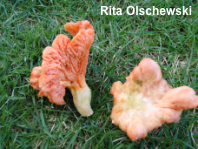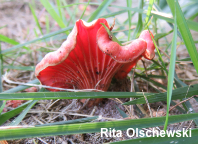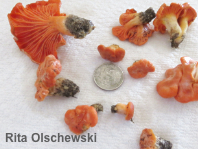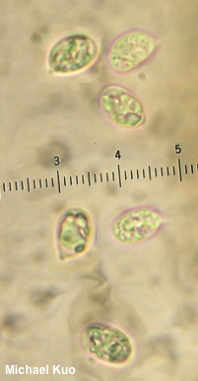| Major Groups > Chanterelles and Trumpets > Cantharellus coccolobae |

|
Cantharellus coccolobae [ Basidiomycota > Cantharellales > Cantharellaceae > Cantharellus . . . ] by Michael Kuo When I think of mycorrhizal mushroom associations, I think of trees: oaks, spruces, pines, and so on. But some mushroom species are mycorrhizal with berry bushes and, in the case of Cantharellus coccolobae, sea grapes—tropical beach plants in the genus Coccoloba that are usually more bush-like than tree-like. In physical features Cantharellus coccolobae is similar to the well-known species Cantharellus cinnabarinus, since it has small, pinkish orange fruiting bodies. However, Cantharellus cinnabarinus is a denizen of temperate hardwood forests, and it differs microscopically. Thanks to Rita Olschewski for documenting, collecting, and preserving Cantharellus coccolobae for study; her collection is deposited in The Herbarium of Michael Kuo. Description: Ecology: Mycorrhizal with sea grapes (plants in the genus Coccoloba); growing alone, scattered, or gregariously in sandy, coastal areas; August and September; known from the Caribbean, the Bahamas, and Florida. The illustrated and described collections are from the Bahamas.Cap: 15–30 mm wide; broadly convex when young, becoming flat or shallowly centrally depressed; bald; moist, with a somewhat waxy appearance; the margin slightly inturned when young, but expanding and becoming arched and wavy with age; dark to pale pinkish orange. Undersurface: With false gills that vary from vein-like and poorly developed to well-developed and gill-like; running down the stem; often with cross-veins; colored like the cap or slightly paler. Stem: 10–20 mm long; 7–10 mm wide; equal when young but by maturity usually tapering to the base; bald; dry; colored like the cap above, but paler toward the base; bruising yellowish, or not bruising; basal mycelium whitish. Flesh: Whitish or tinged with the cap color; yellowing when sliced. Spore Print: Not recorded. Microscopic Features: Spores 6–9 x 4–6 µm; ellipsoid; smooth; inamyloid; hyaline in KOH; multiguttulate. Basidia 4-sterigmate. Elements from cap surface 3–6 µm wide; thin-walled; hyaline to yellowish; clamped at septa; terminal cells cylindric to subclavate. REFERENCES: Buyck, Moreau & Cortecuisse, 2016. (Buyck et al., 2016.) Herb. Kuo 10231801. This site contains no information about the edibility or toxicity of mushrooms. |
© MushroomExpert.Com |
|
Cite this page as: Kuo, M. (2019, May). Cantharellus coccolobae. Retrieved from the MushroomExpert.Com Web site: http://www.mushroomexpert.com/cantharellus_coccolobae.html |



